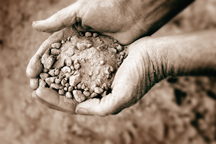 More than 144 homes in a two-square mile southeast of Los Angeles County are the focus of lead contamination test after the California Department of Toxic Substances Control detected high levels of lead in soil near a temporarily closed battery recycling plant. In the fall of 2013, elevated levels of lead at 39 homes and a preschool near the plant were blamed on air pollution from the plant and prompted local officials to issue health warnings and push for additional testing. State regulators expanded the lead soil testing to include more than 144 homes in Vernon, California.
More than 144 homes in a two-square mile southeast of Los Angeles County are the focus of lead contamination test after the California Department of Toxic Substances Control detected high levels of lead in soil near a temporarily closed battery recycling plant. In the fall of 2013, elevated levels of lead at 39 homes and a preschool near the plant were blamed on air pollution from the plant and prompted local officials to issue health warnings and push for additional testing. State regulators expanded the lead soil testing to include more than 144 homes in Vernon, California.
As part of the cleanup at the original test sites, the first 18 inches of soil are being removed from some yards where tests found lead concentration in excess of 580 parts per million (ppm). Lead typically occurs in soils at concentrations that range from 10-50 ppm. In the majority of the 39 homes tested, lead concentration levels exceeded 80 ppm, which is a considered by California Public Health as a “screening” threshold. Anything in excess of 400 ppm is considered potentially harmful, particularly to young children. The contaminated soil is being taken to an Arizona landfill for hazard waste, and new soil will be added to the properties.
The plant has been in operation since 1922 and recycles approximately 25,000 batteries a day. The company that owns the plant blames the contamination on a variety of factors, including lead-based paint used on older homes in the neighborhoods, leaded gasoline, and industrial plants in Vernon; all of which are known culprits for lead contamination. The potential for soils to be contaminated with VOCs is high especially if they are near commercial or manufacturing areas, landfills or a recycling facility such as this one in California.
The amount of contamination typically varies, as can the type of soils from sand, clay or humic. According to the EPA, lead can enter the body by breathing or swallowing lead dust or soil. Lead is extremely harmful to children and adults leading to a variety of ailments, including nerve disorders, high blood pressure, muscle pain and memory problems.
Collecting Contaminated Soil Samples for Analysis
The following steps described below by the College of Agricultural Sciences at Penn State University[i] are typically followed when collecting soil samples for lead analysis.
- Select sites—Take samples from areas suspected of lead contamination such as near roadways or the base of an older home. Also collect samples from high-exposure areas such as garden sites and play areas. Sample each area separately and make a map showing where each sample was collected.
- Collect sample—In undisturbed areas, collect soil from the upper 1–2 inches of the soil. In areas where the soil has been disturbed, and in flowerbeds and vegetable gardens, collect 6-inch-deep samples. If a soil auger or corer is not available, use a shovel to dig a 6-inch-deep hole such that one side exposes a smooth vertical area of soil. Shave a 1-inch-thick slice of soil from this face, keeping it on the shovel. Then collect a 1-inch-wide sample from the center of this slice that reaches from the soil surface to a depth of 6 inches. Take 8–12 samples from a given area, put them together in a clean plastic bucket, and mix well. Take a small subsample (about a cup) and allow it to air dry. Do not heat in an oven or over a register. Put the air-dried sample in a clean plastic bag and seal and label it.
- Send sample—Send sample to a soil-testing lab, where it is analyzed for total sorbed lead (using EPA method 3050 or 3051 or its equivalent), pH, lime requirement, and soil phosphorus.
Many laboratories today use the Prodigy ICP for lead analysis in soil. Contact us for more information on our ICP's and supporting application notes.
[i] http://extension.psu.edu/plants/crops/esi/lead-in-soil

